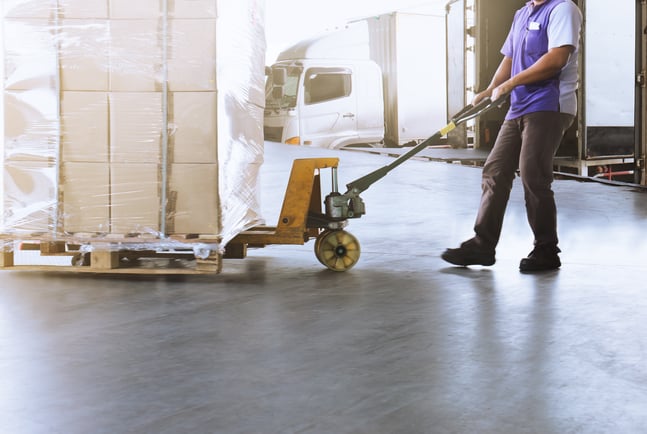10 Industries That Can Benefit Greatly from Robotic Palletizing

Posted on Jan 20, 2023 in Palletizing
5 min read time
Robotic palletizing has become an essential tool for companies in many industries over the last few years. By using robots to automate the stacking and organizing of items for shipment, companies can ship products more efficiently and make better use of their human workers.
The uptake of robotic palletizing has varied across industries. Some industries — such as mass produced consumer goods — have been using robotic automation for decades. Others, such as small scale furniture manufacturing, have only started to use robots more recently.
Thanks to the arrival of robotic palletizing application kits, more companies than ever can benefit from this type of robotic automation. Whatever industry you are in, the robotic technology shouldn't hold you back from getting started with automated palletizing technology.
Here are 10 industries where companies are already benefiting from robotic palletizing:
1. Food and beverages
Robotic palletizing has become instrumental in the food and beverage companies recently, with the industry being a key contributor to the market revenue of automated palletizing. Robots can help companies to streamline shipping even when there are space limitations.
Examples of objects that can be palletized with a robot in the food and beverage industry include bottles and cans, boxes of food products, and shrink-wrapped packages.

2. Medical devices
Robotic palletizing has made a great impact on medical device manufacturers, especially following the 2020 global pandemic where demand soared for medical devices. By automating the packing process, companies can ensure that sensitive items are handled carefully and securely during transportation.
Examples of products that can be palletized with a robot in the medical device sector include small medical instruments, tubing, and medical testing equipment that require careful handling.
3. Automotive
Robotic palletizing has been widely used in the automotive industry for years. The technology is ideal for packaging large parts and components, ensuring that items remain secure during transportation. This technology also helps to reduce the risk of injuries caused by repetitive motion or heavy lifting in the workplace.
Examples of products that can be palletized with a robot in the automotive sector include engine components, electronic components, and tires.
4. Furniture
Robotic palletizing is also becoming increasingly popular in the furniture industry, where there is a need to reduce labor costs and improve efficiency. Furniture manufacturers can also add extra steps to their palletizing process, such as weighing bags of screws and other fixings for self-assembly furniture during the quality assurance stage.
Examples of products that can be palletized with a robot in the furniture industry include sofas, chairs, and cabinet pieces.
5. Logistics
The logistics industry has experienced a huge surge of demand in recent years thanks to the growth of online shopping. As a result, robotic palletizing is becoming an increasingly popular solution to help meet this rising demand. Robots can accelerate the process of palletizing, allowing companies to get products out the door quicker.
Examples of items that can be palletized with a robot in the logistics sector include large shipments of packages, bulk items, and boxes.
6. Packaging
Robotic palletizing is also becoming increasingly popular among packaging manufacturing companies as a scalable way to handle changes in demand.
Examples of products that can be palletized with a robot in the packaging industry include shrink-wrapped packets, fragile containers, and boxes.
One example of a packaging company using palletizing robots to impressive effect is Robotiq client Alliora. They used the Robotiq Palletizing Solution to remove the 23 tons of package weight per shift from the hands of human workers, making their jobs safer, and achieved a payback time of just 18 months. The solution only took them 1 week to integrate.
7. Retail
Retail has changed hugely in recent years and robots are driving much of the innovation. Automated palletizing is just one example of how robots are helping to improve retail operations, in various areas from supply chain management to store operations. Robotic palletizing can help retailers better track inventory, keep shelves stocked faster and more accurately.
Examples of products that can be palletized with a robot in the retail sector include large shipments of clothing, toys, and electronics.
8. Cosmetics
Cosmetics companies often have huge product lines, meaning that there is a need for efficient palletizing. With automated robotic palletizing, this process can be done quickly and accurately. Robots can help cosmetics companies pack and organize items for shipping in a uniform manner, reducing handling costs and ensuring that the right products are shipped to the right customers.
Examples of products that can be palletized with a robot in the cosmetics industry include bottles and tubes of lotions, creams, and makeup.
9. E-commerce
The e-commerce industry is currently experiencing an enormous surge in growth and automated palletizing is helping to meet the demand. With robots able to pack items quickly and accurately, e-commerce companies can save time and money while ensuring that products get safely delivered to their customers.
Examples of products that can be palletized with a robot in the e-commerce sector include books, DVDs, and clothing items.
10. Consumer goods
Robotic palletizing is becoming increasingly popular in the consumer goods industry, where robot sales have been growing for several years now. With robotic palletizing, consumer goods companies can speed up their manufacturing processes, improve product quality and accuracy, reduce labor costs, and increase packing consistency.
Examples of products that can be palletized with a robot in the consumer goods industry include glassware, ceramics, and appliances.
.jpg?width=711&height=474&name=Robotiq%20Palletizing%20Solution_049_04-2021%20(1).jpg)
As you can see, robotic palletizing is benefiting companies in many industries, as businesses look to automation for greater efficiency, accuracy and cost savings.
Do you want to take advantage of robotic palletizing for your business?
If you want to get up and running with robotic palletizing as quickly as possible, check out our palletizing application kit.
Which industry are you in? Tell us in the comments below or join the discussion on LinkedIn, Twitter, Facebook, or the DoF professional robotics community.








Leave a comment